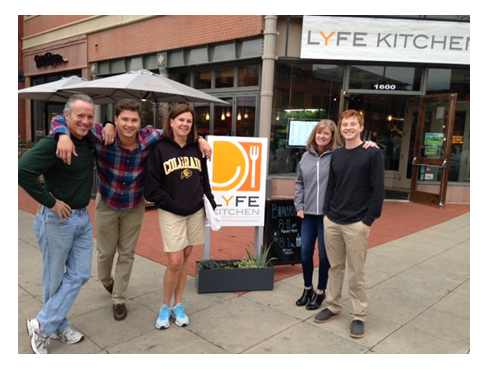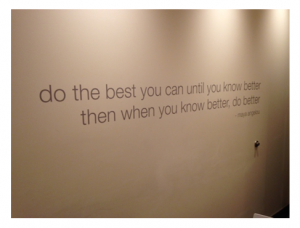There’s more to retaining customers than having a good product.
Lyfe Kitchen seems made to order for progressive Boulder, Colorado. There’s the enviable location on Pearl Street. There’s the tasty, healthy food, favorites like the Quinoa Crunch Bowl and the Edamame Hummus Plate. And there’s the designer space featuring inspiring quotes painted on the walls.
The “foodies” behind the operation clearly designed things to be efficient. Employees use the latest in Point of Sale ordering systems. Instead of dealing with wait staff, customers order at the counter and runners deliver plates to the tables. Order takers at the counter hand guests numbered, wireless pagers to ensure food arrives in the right place. The process appears designed to meet demand with minimum resources.
One would think Lyfe Kitchen had all the right ingredients to become an unqualified success. That may be true for take-out, but dining there on a busy Sunday morning left a lot to be desired. This story is a cautionary tale, describing a situation strikingly similar to Software-as-a-Service (Saas), making this experience a lesson for the tech industry.
Good product, not-so-good experience
 It was Parent’s Weekend at the University of Colorado. Our friends from Chicago were visiting and we were reconnecting with our sons. Typical of a busy Sunday morning in the college town, Boulder’s breakfast eateries reported hour-plus queues. We Googled the alternatives and were told pleasantly, “There’s no wait” when we called Lyfe Kitchen.
It was Parent’s Weekend at the University of Colorado. Our friends from Chicago were visiting and we were reconnecting with our sons. Typical of a busy Sunday morning in the college town, Boulder’s breakfast eateries reported hour-plus queues. We Googled the alternatives and were told pleasantly, “There’s no wait” when we called Lyfe Kitchen.
No host greeted us upon arrival, however. We were told to place our order at the register and to sit at any open table. Our families stood in line and placed separate orders. We snagged a comfortable table nearby that seated six.
Soon, however, getting a cup of java proved frustrating. We asked the busy runners to bring some, but had no luck after a couple of failed attempts. We finally got up, found a stack of clean cups, and asked for a carafe at the counter.
One food order eventually arrived at our table, but since neither wireless pager lit up, we weren’t exactly sure whose it was. We guessed the rest would be coming shortly. Ever polite, our wives hovered over their plates. “Can’t let it get cold,” was the final determination, and they enjoyed the first meals.
![]() An interminable wait followed. Runners brought the wrong food—twice—the pagers never activating. Meantime our coffee ran out, our expedition to find and fill water glasses on our own failed, and our dirty dishes simply sat. Eventually the remaining meals came and we ate them hungrily.
An interminable wait followed. Runners brought the wrong food—twice—the pagers never activating. Meantime our coffee ran out, our expedition to find and fill water glasses on our own failed, and our dirty dishes simply sat. Eventually the remaining meals came and we ate them hungrily.
Breaking with tradition, Lyfe Kitchen assumed they didn’t need certain staff—customers would “self- serve” and process and technology would handle the rest. They didn’t anticipate we and other patrons would need coffee refills, pagers would fail, or orders could arrive awkwardly at different times. Doing away with servers may have offered the owners lower costs, but at the price of our loyalty.
Different industry, same issues
In the same way as Lyfe Kitchen, many SaaS firms expect their customers to fend for themselves. Automation prompts customers to purchase, access, download, learn and use new software. But things can go wrong in software, too: e-mails go to junk filters, browsers crash, and remote databases fail to connect. SaaS executives assume their customers will simply contact Customer Service if anything goes wrong. But as in this example, a poorly designed customer experience guarantees reliance on Customer Service to solve problems that could have otherwise been avoided.
Complicating matters is the widespread notion that in order to scale profitably, SaaS companies must do away with the human touch. Product-centric and transaction-focused, tech executives believe the story begins and ends with superior technology. They think high customer loyalty comes exclusively from high product value; attentiveness to individual needs is costly and unnecessary.
As this example shows, however, a little caring can go a long way. True, having dedicated staff attending to every desire may not make financial sense in every situation. But a personal connection at the right time and taking ownership of the customer’s experience can make all the difference.
A way forward
The SaaS industry’s growing Customer Success movement is a healthy response. Many executives are starting to realize that
 proactively boosting early product usage, achieving successful outcomes, and systematically building customer trust results in more revenue. New Customer Success teams not only intervene personally but also help all areas of the business increase customer retention. Tech companies are getting smarter about blending both human and automated techniques to get the job done more effectively and efficiently, too.
proactively boosting early product usage, achieving successful outcomes, and systematically building customer trust results in more revenue. New Customer Success teams not only intervene personally but also help all areas of the business increase customer retention. Tech companies are getting smarter about blending both human and automated techniques to get the job done more effectively and efficiently, too.
Still, many SaaS companies (and sadly Lyfe Kitchen itself) can benefit from the late poet Maya Angelou’s quote painted on the restaurant’s wall: “Do the best you can until you know better; then when you know better, do better.”
Now you know better. There’s more to retaining customers than having a good product.
Did you enjoy this article? Subscribe to Excel-lens now and never miss another post.
